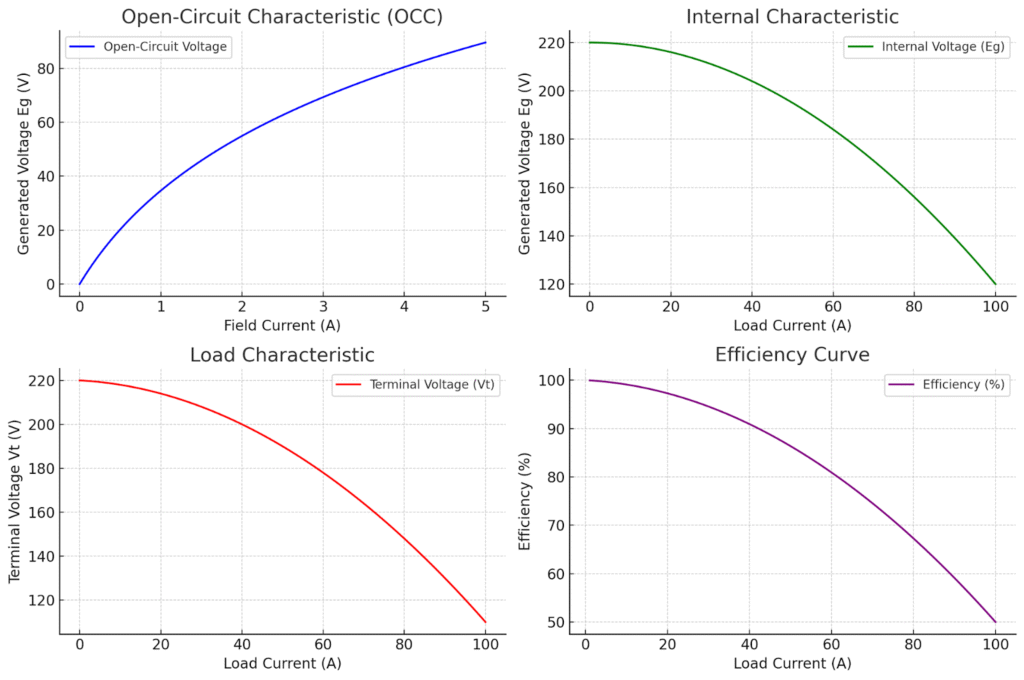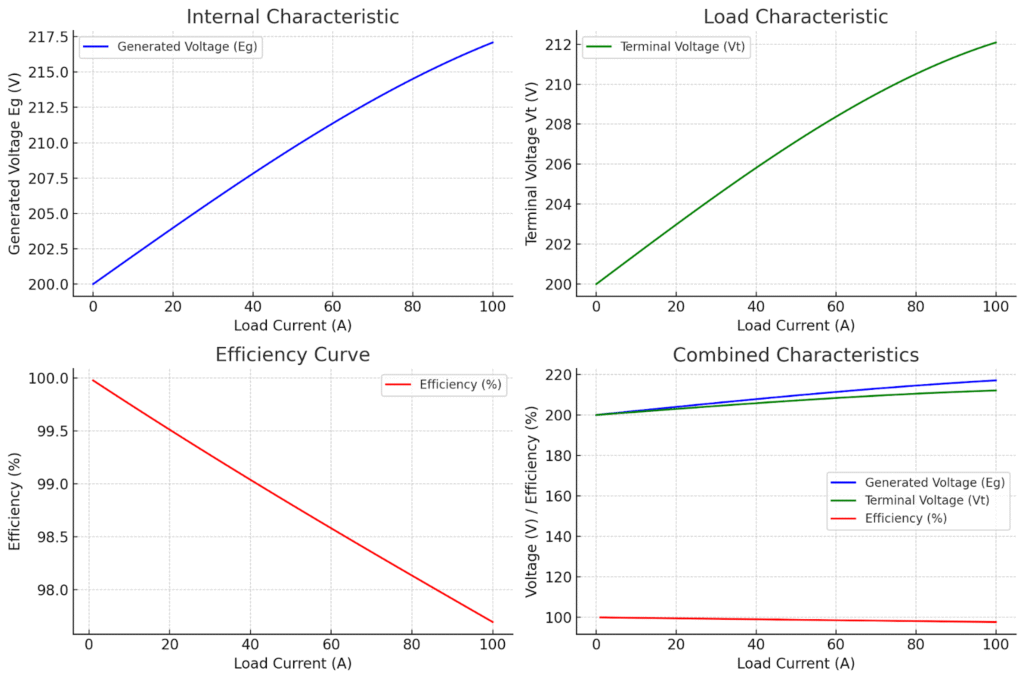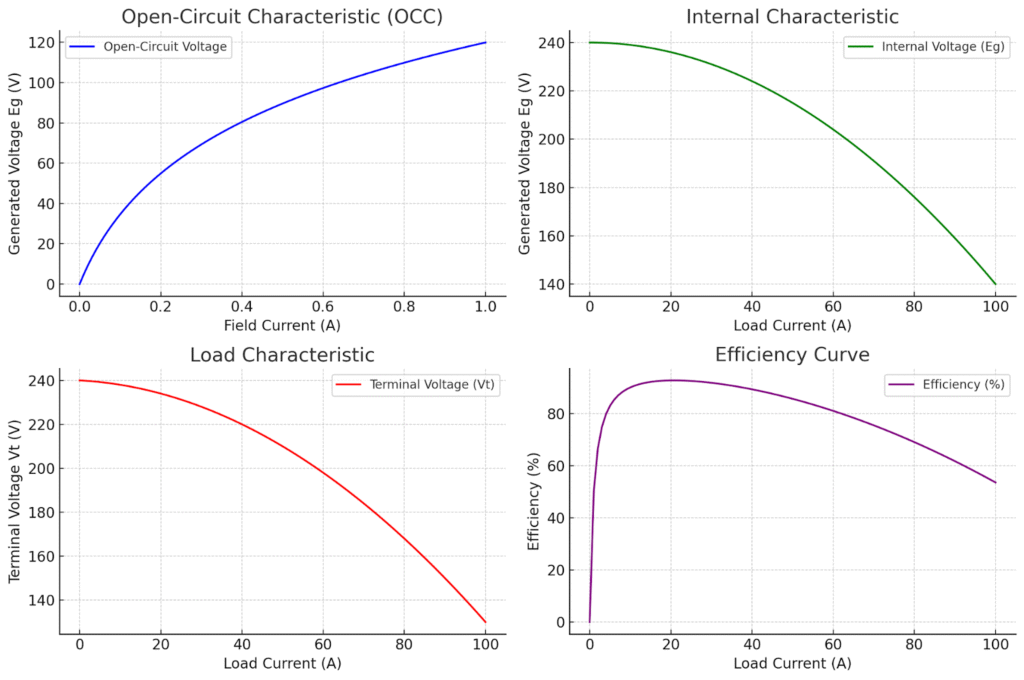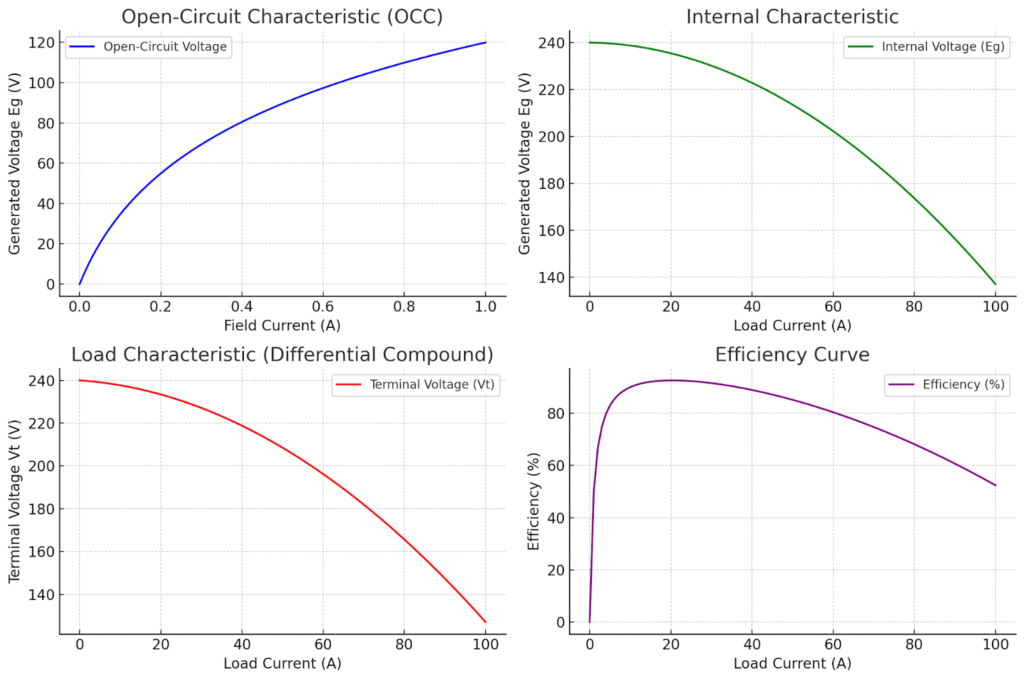Justifying the Choice of Generators Based on Requirements and Characteristics
Introduction
Selecting the right generator isn’t just about power output, it’s about finding a machine that meets specific operational needs, efficiency goals, and environmental conditions. Different applications demand different generator types, capacities, and features. In this article, we’ll explore how to justify the choice of a generator based on its characteristics, such as voltage, frequency, fuel type, and load capacity, and match these with the unique requirements of various power systems.
Applications of DC Generators

There are various types of DC generators available for several types of services. The applications of these DC generators based on their characteristic are discussed below:
Separately Excited DC Generators
Separately excited DC generators are versatile electrical machines where the field winding is energized by an external DC source, allowing precise control over the magnetic field and output voltage. This feature makes them highly suitable for applications requiring a stable and adjustable power supply. These generators are commonly used in laboratories, industrial processes, and systems where accurate voltage regulation is critical. Their ability to provide reliable performance under varying load conditions makes them essential for tasks like testing, excitation of alternators, and powering sensitive equipment.
By understanding their applications, we can appreciate their importance in delivering precise and consistent power in diverse operational scenarios. Let’s explore their specific uses in more detail.
Shunt Wound DC Generators
Shunt wound DC generators have the field winding connected in parallel with the armature winding. This configuration ensures that the field current remains relatively constant regardless of load changes, making them suitable for applications requiring a stable and consistent voltages.
Used in systems where a steady and regulated voltage is essential for charging batteries. Ideal for processes requiring a stable DC voltage to deposit metals or form shapes in industrial applications. Used as exciters to supply the necessary field current to alternators for consistent magnetic field generation. Provide stable power for street lighting, emergency lighting, and other applications where voltage stability is critical. Commonly used in small-scale power systems for workshops, offices, and similar environments requiring low power. Preferred in labs for testing electrical equipment due to their ability to provide consistent voltage under varying loads.
Shunt wound DC generators are reliable voltage regulation under moderate load variations. Simple design and ease of maintenance. Cost-effective for low to medium power applications.
Series Wound DC Generators
Series wound DC generators have their field winding connected in series with the armature winding. In this configuration, the field current is the same as the load current, which makes the field strength directly proportional to the load.
These generators are known for their ability to produce high starting torque, making them suitable for applications requiring a strong current at varying loads.Used in electric trains, trams, and trolleys due to their ability to handle varying load conditions effectively.Ideal for heavy lifting applications where high starting torque is essential. Used in arc welding systems where variable and high current is required to melt metals.Suitable for charging batteries in applications where fluctuating load currents are acceptable. Used in industries for electrolysis, which requires high current for chemical decomposition processes. Can act as boosters in DC power supply systems to compensate for voltage drops in long transmission lines.
Series wound DC generators have high starting torque, ideal for heavy-duty applications. Simple construction and robust design for demanding environments. Suitable for varying load conditions where high current is needed.
While series wound DC generators are not commonly used for precise or stable voltage applications, their unique characteristics make them valuable in specific industrial and transportation systems requiring high current output.
Compound Wound DC Generators
Compound wound DC generators combine the characteristics of both series and shunt wound generators. They have both series and shunt field windings, which can be configured to work together (cumulatively compounded) or against each other (differentially compounded). These generators offer excellent voltage regulation and adaptability, making them suitable for a wide range of applications.
Cumulatively Compound: Used in industrial power systems requiring stable voltage under varying load conditions. Ideal for street lighting, theatres’, and other scenarios where steady voltage is critical. Suitable for powering motors and equipment in factories where variable loads are common. Used in railway electrification systems to power trains and auxiliary systems. Excellent for charging batteries where slight variations in load occur.
Differentially Compounded DC Generators: Used in welding applications where a slightly decreasing voltage with increasing current is required.Occasionally used in processes requiring controlled reduction in voltage as the load increases.
Cumulatively compounded generators maintain a nearly constant output voltage, even under varying loads. The series winding provides additional magnetic field strength, delivering high torque during startup. Suitable for a combination of steady and variable load applications. Reliable performance in systems where load conditions frequently change. Compound wound DC generators are widely used in industries, transportation, and power systems where a balance between stability and flexibility is required. Their adaptability makes them indispensable in a variety of practical applications.
Rating of Alternator
The power rating of an alternator refers to the maximum electrical power it can generate under specified operating conditions without overheating or sustaining damage. It is typically expressed in kilowatts (kW) or kilovolt-amperes (kVA), depending on whether power factor considerations are included.

Key Components of Power Rating
Apparent Power (S): Measured in kVA (kilovolt-amperes).Represents the total power the alternator can handle, including active and reactive power.
Apparent power is calculated as: S = V x I
Where: V: Voltage in volts, I: Current in amperes
Active Power (P): Measured in kW (kilowatts). Represents the actual usable power delivered to the load.
Active power is given by: P = S x Power Factor (PF)
Power Factor (PF):Represents the efficiency of power usage, typically a value between 0 and 1.A common power factor for alternators is 0.8 (lagging) in industrial and commercial applications.
Voltage and Frequency:
Power rating is specified for a certain voltage (e.g., 415V, 11kV) and frequency (50Hz or 60Hz).
Example Power Rating
If an alternator is rated at 500 kVA with a power factor of 0.8, its active power is:
P = 500 kVA × 0.8 = 400 kW
Factors Affecting Alternator Power Rating
Cooling System: Effective cooling (air or water) allows higher power ratings by dissipating heat.
Ambient Temperature: Higher ambient temperatures may reduce the alternator’s power rating.
Duty Cycle: Continuous or intermittent operation affects the maximum allowable power output.
Efficiency:Higher efficiency allows for more usable power output.
Importance of Power Rating Ensures the alternator can handle the connected load without overloading. Operating within the power rating prevents overheating and wear, prolonging the alternator’s lifespan. Avoids risks associated with exceeding thermal or mechanical limits. The table below shows a standard rating plate of alternator

DC Generators Performance Curves
The performance curves of a DC generator are graphical representations that illustrate how the generator behaves under varying operating conditions. These curves help analyse the relationships between key parameters such as voltage, current, power, and efficiency, providing insights into the machine’s performance.
DC generator performance curves are essential for: Understanding Machine Behavior: Design and Selection, and performance Optimization:
By studying these curves, one can evaluate the generator’s voltage regulation, efficiency, and load-handling capabilities under practical working conditions.
Performance Curve of Separately Excited DC Generator
The performance curves of a separately excited DC generator illustrate the relationships between various operating parameters, such as the terminal voltage, load current, efficiency, and generated EMF. These curves help evaluate the generator’s behaviour under different conditions and are crucial for design, operation, and optimization.

Open Circuit Characteristic (OCC) (no-load Characteristics): Shows the relationship between the field current (If) and the generated EMF (E) at constant speed when there is no load on the generator. Initially, the curve is linear as the magnetic flux increases with the field current. At higher field currents, the curve saturates due to the magnetic saturation of the core. Determines the voltage build-up capability. Used to select the appropriate field excitation for desired output voltage.
External Characteristic (Load Characteristic) Represents the relationship between terminal voltage (V) and load current (IL) at constant field excitation. The terminal voltage decreases slightly as the load current increases due to the voltage drop across the armature resistance (IaRa ) and armature reaction. Indicates the voltage regulation of the generator under load. Important for applications requiring stable voltage.
Internal Characteristic Plots the generated EMF (E) versus load current (IL), accounting for the armature reaction but not armature resistance. Lies above the external characteristic because it excludes the voltage drop across the armature resistance. Useful for analyzing the effects of armature reaction.
Efficiency Curve Shows the variation of efficiency (η) with output power or load current. Efficiency is low at very light and very high loads due to constant losses and higher resistive losses, respectively. Peaks at a specific load where the losses are minimized. Helps determine the most efficient operating range.
Performance Curve of Series Wound DC Generator
The performance curve of a series-wound DC generator represents the relationship between key parameters such as generated voltage, load current, and efficiency. A series-wound DC generator has its field windings connected in series with the armature, meaning the field current is the same as the armature current. This design gives it distinct performance characteristics.

Open-Circuit Characteristic (OCC): Shows the relationship between generated voltage Eg and field current If when no load is connected. The curve initially rises steeply due to high magnetic flux at low field currents but eventually saturates because of magnetic saturation of the core.
Load Characteristic (External Characteristic): Represents the terminal voltage Vt versus load current IL. At low currents, the voltage increases because the field flux increases with load current. However, as current increases further, Vt begins to drop due to:Armature reaction (distortion of the main field). Voltage drop across the armature resistance and field windings.
Internal Characteristic:Represents the generated voltage Eg versus load current IL. Differs from the load characteristic by the amount of voltage drop due to internal resistance.
Efficiency Curve: Plots efficiency against load current. Efficiency increases initially as losses (like core and stray losses) are spread over increasing output power. It peaks and then decreases as copper losses (I2R) dominate at higher currents.
Voltage builds up as load increases, up to a certain point. Beyond this point, excessive current causes voltage to drop due to increased internal resistance and saturation effects. Not suitable for constant-voltage applications but useful in applications like arc welding or supplying power to traction systems.
Performance Curve of Shunt Wound DC Generator
The performance curve of a shunt-wound DC generator represents the relationship between parameters like terminal voltage, load current, and efficiency. In this type of generator, the field winding is connected in parallel (shunt) with the armature, and the field current is independent of the load current, giving the generator specific characteristics.

Open-Circuit Characteristic (OCC): The relationship between the generated voltage Eg and the field current If at no load. Initially linear, the curve saturates due to the magnetic core.
Internal Characteristic: Shows the generated voltage Eg versus armature current Ia. Decreases slightly with increasing load due to armature reaction.
Load Characteristic (External Characteristic): Represents the terminal voltage Vt versus load current IL. The terminal voltage decreases with increasing load current due to: Voltage drop across armature resistance. Slight reduction in Eg due to armature reaction. Field weakening as terminal voltage drops.
Efficiency Curve: Efficiency increases with load current up to a point, then decreases due to increasing copper losses.
Performance Curve of Compound Wound DC Generator
The performance curve of a compound-wound DC generator reflects the combined characteristics of both series and shunt-wound generators. The compound generator has both series and shunt field windings, which can be connected in two ways: cumulative compound (series and shunt fluxes add up) or differential compound (series and shunt fluxes oppose each other).

Open-Circuit Characteristic (OCC): Represents the relationship between generated voltage Eg and field current If under no load. Similar to that of a shunt generator, it shows saturation at higher field currents.
Internal Characteristic:Displays the relationship between generated voltage Eg and armature current Ia, showing a slight decrease due to armature reaction.
Load Characteristic (External Characteristic):
Cumulative Compound: The terminal voltage Vt initially decreases with load current but may rise slightly at higher loads due to the series winding’s contribution.
Differential Compound: The terminal voltage drops sharply as the series field opposes the shunt field.
Efficiency Curve: Efficiency rises with increasing load, peaks, and then decreases as copper losses dominate.
Interested in our Electrical Engineering Courses?
At iLearn Engineering®, we offer a diverse range of online accredited electrical engineering courses and qualifications to cater to different academic and career goals. Our courses are available in varying credit values and levels, ranging from 40 credit Engineering Diplomas to a 360 credit International Graduate Diploma.
Short Courses (40 Credits)
A selection of our more popular 40 credit electrical diplomas…
Diploma in Electrical and Electronic Engineering
Diploma in Electrical Technology
Diploma in Renewable Energy (Electrical)
First Year of Undergraduate (Level 4 – 120 Credits)
Higher International Certificate in Electrical and Electronic Engineering
First Two Years of Undergraduate (Level 5 – 240 Credits)
Higher International Diploma in Electrical and Electronic Engineering.
Degree equivalent Graduate Diploma (Level 6 – 360 Credits)
International Graduate Diploma in Electrical and Electronic Engineering
All Electrical and Electronic Courses
You can read more about our selection of accredited online Electrical and Electronic Engineering courses here.
Complete Engineering Course Catalogue (all courses)
Alternatively, you can view all our online engineering courses here.
Recent Posts
Understanding and Calculating Generator Efficiency and Output Parameters
Understanding and Calculating Generator Efficiency and Output Parameters Introduction The performance of a generator is often judged by how efficiently it converts mechanical energy into electrical energy. Understanding and calculating this efficiency, along with other key output parameters such as voltage, current, power factor, and load, is essential for evaluating performance and ensuring reliable operation. […]
Essential Cooling and Protection Devices: How They Work and Why They Matter
Essential Cooling and Protection Devices: How They Work and Why They Matter Introduction Generators produce a significant amount of heat and electrical stress during operation, which can affect performance and lifespan if not properly managed. That’s where cooling and protection devices come in. These essential systems, including fans, radiators, circuit breakers, and relays, work together […]
How to Choose the Perfect Generator for Your Home Power Needs
How to Choose the Perfect Generator for Your Home Power Needs Introduction When the lights go out, having a reliable generator can make all the difference. Whether you’re preparing for unexpected power outages or looking to keep essential appliances running during storms, choosing the right generator for your home is key. In this guide, we’ll […]

